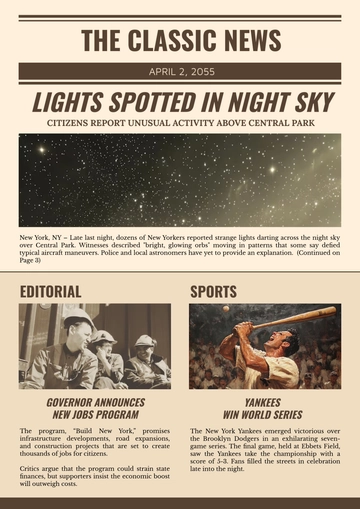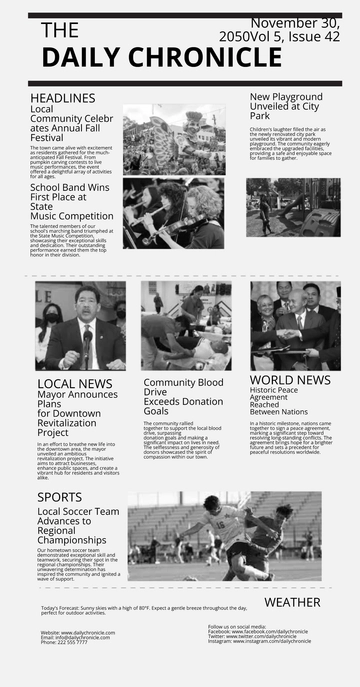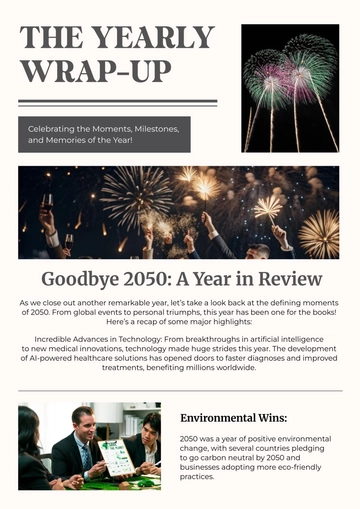Free Student Newspaper

Prepared by: [Your Name]
Date: [Date]
1. Introduction
In recent months, the campus has embarked on a transformative journey towards sustainability. Spearheaded by the Student Sustainability Committee, new initiatives aim to reduce the environmental impact of our institution while promoting eco-friendly practices among students and faculty. This article explores these initiatives, their objectives, and their anticipated effects on campus life.
2. Key Initiatives
2.1. Green Energy Transition
The university has committed to transitioning 50% of its energy consumption to renewable sources by 2050. This includes:
Solar Panels: Installation of solar panels on the roofs of academic buildings and dormitories.
Wind Turbines: Plans to erect wind turbines on the campus outskirts.
Energy Efficiency Programs: Upgrades to lighting and HVAC systems to enhance energy efficiency.
2.2. Waste Reduction Strategies
Aiming to achieve a zero-waste campus, the following strategies are being implemented:
Recycling Stations: New recycling bins have been placed across campus, including in dorms and dining areas.
Composting Programs: Introduction of composting bins in dining halls and common areas.
Digital Transition: Moving away from paper-based communications and reports to digital formats.
2.3. Sustainable Transportation
To encourage green transportation, the university is focusing on:
Bike Share Program: Expansion of the bike share program with more stations and bikes.
Electric Vehicle Charging Stations: Installation of additional EV charging stations in parking areas.
Carpooling Incentives: Initiatives to promote carpooling, including reserved parking spots for carpool vehicles.
3. Impact on Campus Community
3.1. Student Involvement
Students are actively engaged in these sustainability efforts through:
Volunteer Programs: Opportunities to participate in campus clean-up drives and sustainability workshops.
Student Organizations: Clubs such as Eco Warriors and Green Campus Coalition are leading awareness campaigns and events.
Internships: Students can apply for internships with the Sustainability Office to gain hands-on experience in environmental management.
3.2. Faculty and Administration Support
Faculty and administration are playing a crucial role by:
Curriculum Integration: Incorporating sustainability topics into coursework and research projects.
Policy Development: Supporting new policies that align with sustainability goals.
Resource Allocation: Providing funding and resources to support green initiatives.
4. Challenges and Solutions
4.1. Implementation Challenges
The following challenges have been encountered during the implementation of sustainability initiatives:
Funding Limitations: Securing sufficient funding for large-scale projects.
Student Participation: Encouraging widespread student engagement in sustainability programs.
Infrastructure Limitations: Adapting existing infrastructure to accommodate new sustainability measures.
4.2. Proposed Solutions
To address these challenges, the university is proposing:
Increased Funding: Seeking grants and partnerships to supplement funding for sustainability projects.
Awareness Campaigns: Launching targeted campaigns to boost student involvement and awareness.
Infrastructure Upgrades: Investing in necessary infrastructure upgrades to support new initiatives.
5. Community Outreach and Engagement
5.1. Local Partnerships
The university is collaborating with local organizations to enhance sustainability efforts:
Environmental Nonprofits: Partnering with local nonprofits to support community-based environmental initiatives.
Local Businesses: Working with businesses to promote sustainable practices and green technologies.
Public Workshops: Hosting workshops and seminars to educate the local community about sustainability.
5.2. Student-Faculty Collaboration
Enhanced collaboration between students and faculty is encouraged through:
Joint Research Projects: Initiating research projects that involve both students and faculty in sustainability studies.
Guest Lectures: Inviting experts to speak on sustainability topics and provide insights into best practices.
Collaborative Events: Organizing events that bring together students, faculty, and community members to discuss sustainability.
6. Future Plans and Goals
6.1. Long-term Vision
The university’s long-term vision includes:
Carbon Neutrality by 2055: Achieving a carbon-neutral campus through continued investment in renewable energy and efficiency measures.
Expansion of Green Spaces: Increasing the number of green spaces on campus to enhance biodiversity and student well-being.
Community Outreach: Partnering with local communities to share sustainability practices and collaborate on regional environmental projects.
6.2. Measuring Success
Success will be measured by:
Annual Sustainability Reports: Regular updates on progress towards sustainability goals.
Feedback Surveys: Collecting feedback from students, faculty, and staff to assess the effectiveness of initiatives.
Environmental Impact Assessments: Conduct assessments to evaluate the environmental benefits of implemented programs.
7. Conclusion
The commitment to sustainability represents a significant step forward in creating a greener campus environment. Through collaborative efforts among students, faculty, and administration, the university is setting a precedent for other institutions to follow. As these initiatives take shape, the campus community can look forward to a more sustainable and environmentally responsible future.
- 100% Customizable, free editor
- Access 1 Million+ Templates, photo’s & graphics
- Download or share as a template
- Click and replace photos, graphics, text, backgrounds
- Resize, crop, AI write & more
- Access advanced editor
Create your perfect student newspaper with the Student Newspaper Template from Template.net. Fully customizable and editable in our Ai Editor Tool, this template allows you to craft unique and engaging content effortlessly. Ideal for any school publication, it offers professional layouts and designs, ensuring your newspaper stands out while saving you time.





























